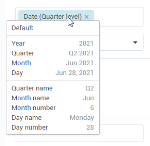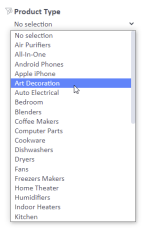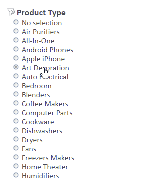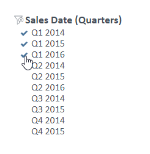Add highlighter widgets
When you have one or more visualizations on a storyboard, you can add a highlighter widget to highlight data in the visualizations. Thus, the visualizations will display the selected categories framed in blue. For details, see Highlighter.
Prerequisites
- You created a storyboard, or you have access to one. For details on creating storyboards, see Add a storyboard.
- The storyboard page with the visualizations where you want to highlight data is open in the page area.
- You have at least one empty cell on the storyboard.
Procedure
On the Storyboards toolbar, click
 Enable changes, and then click
Enable changes, and then click  Add widget.
Add widget.The Widgets pane appears.
Click the
 visualizations tab, and then click the Tabular category.
visualizations tab, and then click the Tabular category.Point to the
 Highlight widget, and then drag it to an empty cell in the page area.
Highlight widget, and then drag it to an empty cell in the page area.The widget settings pane appears on the left of the page area.
Tip: You can also add a highlighter by clicking the Click here to add widget link, which is available in each empty cell of the page area. From the list that appears, select the highlighter widget. In this list, the visualization widgets are not grouped by category.
On the
 data tab, expand the Highlighters section, and then click
data tab, expand the Highlighters section, and then click  manage highlighters.
manage highlighters.The Highlighters pane appears.
Click New in the upper-right corner, and then define the following settings:
 Dataset
DatasetSelect the dataset used for the visualizations that you want to highlight. All the visualizations must use the same dataset.
 Filters: By default, the highlighter widget displays all the values from the dataset. However, you can filter the values to be displayed in the highlighter widget. For example, you filtered the line chart to show the dates for a specific year, and you want the highlighter widget for the date column to display only the dates for that year.
Filters: By default, the highlighter widget displays all the values from the dataset. However, you can filter the values to be displayed in the highlighter widget. For example, you filtered the line chart to show the dates for a specific year, and you want the highlighter widget for the date column to display only the dates for that year.For more information on how to define filters, see Add filters.
 Type
TypeYou can use the following highlighter types:
Dropdown – Select one option from the dropdown list.
Single select – Select one option from the list.
Multi select – Select several options from the list.
Expression – Enter a mathematical expression that you want to use for highlighting the data in a non-aggregated status. For example, if you use the Sales Cost column and enter the expression >100, the visualization data items for which the sales cost is higher than 100 will be highlighted.
You can use the following symbols.
Symbol Use this item to = Show only the data items whose value is equal to the specified value. For example, use "=100" to show only the data whose value is equal to 100.
> Show only the data items whose value is greater than the specified value. For example, use ">100" to show only the data whose value is greater than 100.
>= Show only the data items whose value is greater than or equal to the specified value. For example, use ">=100" to show only the data whose value is greater than or equal to 100.
< Show only the data items whose value is less than the specified value. For example, use "<100" to show only the data whose value is less than 100. <= Show only the data items whose value is less than or equal to the specified value. For example, use "<=100" to show only the data whose value is less than or equal to 100.
><
<>
Show a range of numeric values. For example, use ">100<500" to show only the data whose value is more than 100 and less than 500, or "<500>100" to show only the data whose value is less than 500 and more than 100.
>= <=
<= >=
Show a range of numeric values. For example, use ">=100<=500" to show only the data whose value is greater than or equal to 100 and less than or equal to 500, or "<=500>=100" to show only the data whose value is less than or equal to 500 and greater than or equal to 100. This highlighter type is available if you select a column that contains measures.
 Target widget
Target widgetClick in the box under Type, and then, in the list, select the visualization that you want to highlight. When you point to a visualization in the list, that specific visualization is framed in red on the storyboard. You can select one or more visualizations to highlight at the same time.
The Target widget list displays only the visualizations on the storyboard page that have the same dataset that you selected in the Dataset field and the same column that you selected in the Column field.
 Name
NameIn the Name field, enter a name for the highlighter.
Tip: To quickly add a highlighter to the storyboard, click the arrow button next to the New button in the upper-right corner, and then click the needed highlighter type on the shortcut menu. The Type and Name fields are filled in automatically with the highlighter type that you selected and a default name, respectively.
Click Apply, and then close the widget settings pane.
The highlighter is displayed on the storyboard, and you can use it to highlight the visualizations.
To clear the selections, click
 clear selection in front of the highlighter name.
clear selection in front of the highlighter name.Click
 Save on the Storyboards toolbar.
Save on the Storyboards toolbar.Tip: To improve the design of the storyboard, use the Snap to cell feature for all the widgets on the page. To place widgets on top of each other, use the Bring to front and Send to back features. For details, see Arrange widgets on a storyboard.





Comments
0 comments